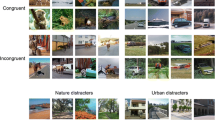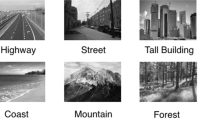Summary
In a number of studies the context provided by a real-world scene has been claimed to have a mandatory, perceptual effect on the identification of individual objects in such a scene. This claim has provided a basis for challenging widely accepted data-driven models of visual perception in order to advocate alternative models with an outspoken top-down character. The present paper offers a review of the evidence to demonstrate that the observed scene-context effects may be the product of post-perceptual and task-dependent guessing strategies. A new research paradigm providing an on-line measure of genuine perceptual effects of context on object identification is proposed. First-fixation durations for objects incidentally fixated during the free exploration of real-world scenes are shown to increase when the objects are improbable in the scene or violate certain aspects of their typical spatial appearance in it. These effects of contextual violations are shown to emerge only at later stages of scene exploration, contrary to the notion of schema-driven scene perception effective from the very first scene fixation. In addition, evidence is reported in support of the existence of a facilitatory component in scene-context effects. This is taken to indicate that the context directly affects the ease of perceptual object processing and does not merely serve as a framework for checking the plausibility of the output of perceptual processes. Finally, our findings are situated against other contrasting results. Some future research questions are highlighted.
Similar content being viewed by others
References
Antes, J. R. (1974). The time course of picture viewing.Journal of Experimental Psychology, 3, 62–70.
Antes, J. R., Mann, S. M., & Penland, J. G. (1981).Local precedence in picture naming: The importance of obligatory objects. Paper presented at the 1981 meeting of the Psychonomic Society.
Antes, J. R., & Penland, J. G. (1981). Picture context effects on eye movement patterns. In D. F.Fischer, R. A.Monty, & J. W.Senders (Eds.),Eye movements: Cognition and visual perception (pp. 157–170). Hillsdale, NJ: Erlbaum.
Antes, J. R., Penland, J. G., & Metzger, R. L. (1981). Processing global information in briefly presented pictures.Psychological Research, 43, 277- 292.
Antes, J. R., Singsaas, P. A., & Metzger, R. L. (1978). Components of pictorial informativeness.Perceptual and Motor Skills, 47, 459–464.
Biederman, I. (1981). On the semantics of a glance at a scene. In M. Kubovy & J. R.Pomerantz (Eds.),Perceptual Organization. Hillsdale, NJ: Erlbaum.
Biederman, I. (1987). Recognition-by-components: A theory of human image understanding.Psychological Review, 94, 115–147.
Biederman, I. (1988). Aspects and extensions of a theory of human image understanding. In Z. W.Pylyshyn (Ed.),Computational processes in human vision: An interdisciplinary approach (pp. 370–428). Norwood, NJ: Ablex.
Biederman, I., Mezzanotte, R. J., & Rabinowitz, J. C. (1982). Scene perception: Detecting and judging objects undergoing relational violations.Cognitive Psychology, 14, 143–177.
Boyce, S. J., Pollatsek, A., & Rayner, K. (1989). Effects of background information on object identification.Journal of Experimental Psychology: Human. Perception and Performance, 15, 556–566.
Carr, T. H., McCauley, C., Sperber, R. D., & Parmelee, C. M. (1982). Words, pictures and priming: On semantic activation, conscious identification, and the automaticity of information processing.Journal of Experimental Psychology: Human Perception and Performance, 8, 757–777.
Cliff, N. (1987).Analyzing multivariate data. Orlando, FL: Harcourt.
Friedman, A. (1979). Framing pictures: The role of knowledge in automatized encoding and memory for gist.Journal of Experimental Psychology: General, 108, 316–355.
Hanson, A. R., & Riseman, E. M. (1978). VISIONS: A computer system for interpreting scenes. In A.Hanson & E.Riseman (Eds.),Computer vision systems (pp. 303–333). New York: Academic Press.
Henderson, J. M., Pollatsek, A., & Rayner, K. (1987). Effects of foveal priming and extrafoveal preview on object identification.Journal of Experimental Psychology: Human Perception and Performance, 13, 449–463.
Henderson, J. M., Pollatsek, A., & Rayner, K. (1989). Covert visual attention and extrafoveal information use during object identification.Perception & Psychophysics, 45, 196–208.
Huttenlocher, J., & Kubicek, L. F. (1983). The source of relatedness effects on naming latency.Journal of Experimental Psychology: Learning, Memory and Cognition, 9, 486–496.
Inhoff, A. W. (1984). Two stages of word processing during eye fixations in the reading of prose.Journal of Verbal Learning and Verbal Behavior, 23, 612–624.
Kirk, R. E. (1982).Experimental design: Procedures for the behavioral sciences. Monterey, CA: Brooks/Cole.
Klatsky, G. J., Teitelbaum, R. C., Mezzanotte, R. J., & Biederman, I. (1981). Mandatory processing of the background in the detection of objects in scenes.Proceedings of the Human Factors Society, 25, 272–276.
Kroll, J. F., & Potter, M. C. (1984). Recognizing words, pictures and concepts: A comparison of lexical, object and reality decisions.Journal of Verbal Learning and Verbal Behavior, 23, 39–66.
Locher, P. J., & Nodine, C. F. (1987). Symmetry catches the eye. In J. K.O'Regan & A.Levy-Schoen (Eds.),Eye Movements: From Physiology to Cognition (pp. 353 - 361) North-Holland: Elsevier.
Loftus, G. R. (1983). Eye fixations on text and scenes. In K. Rayner (Ed.),Eye movements in reading (pp. 359 - 376). New York: Academic Press.
Loftus, G. R., & Mackworth, N. H. (1978). Cognitive determinants of fixation location during picture viewing.Journal of Experimental Psychology: Human Perception and Performance, 4, 565 - 572.
Loftus, G. R., Nelson, W. W., & Kallman, H. J. (1983). Differential acquisition rates for different types of information from pictures.Quarterly Journal of Experimental Psychology, 35A, 187 -198.
McArthur, D. J. (1982). Computer vision and perceptual psychology.Psychological Bulletin, 92, 283 - 309.
Marr, D. (1978). Representing visual information: A computational approach. In A. R.Hanson & E. M. Riseman (Eds.),Computer vision systems (pp. 61 - 80). Orlando, FL: Academic Press.
Marr, D. (1982).Vision: A computational investigation into the human representation and processing of visual information. San Francisco: Freeman.
Metzger, R. L., Antes, J. R. (1983). The nature of processing early in picture perception.Psychological Research, 45, 267 - 274.
Nodine, C. E., Carmody, D. P., & Kundel, H. L. (1978). Searching for NINA. In J. W.Senders, D. F.Fisher, & R. A.Monty (Eds.),Eye movements and the higher psychological functions (pp. 241 - 258). Hillsdale, NJ: Erlbaum.
Palmer, S. E. (1975). Visual perception and world knowledge: Notes on a model of sensory-cognitive interaction. In D. A.Norman & D. E.Rumelhart (Eds.),Explorations in cognition (pp. 279 - 307). San Francisco: Freeman.
Rayner, K., & Pollatsek, A. (1987). Eye movements in reading: A tutorial review. In M. Coltheart (Ed.),Attention and Performance XII, (pp. 327 - 362). London: Erlbaum.
Riseman, E. M., & Hanson, A. R. (1987). A methodology for the development of general knowledge-based vision systems. In M. Arbib & A.Hanson (Eds.),Vision, brain and cooperative computation (pp. 285 - 328). Cambridge: MIT Press.
Schank, R. (1982).Dynamic memory. A theory of reminding and learning in computers and people. Cambridge: Cambridge University Press.
Verfaillie, K., & Wagemans, J. (1987).Constraints in perception and cognition of objects, scenes and events. Psychological Report, 72, Laboratory of Experimental Psychology, University of Leuven, Belgium.
Young, L. R., & Sheena, D. (1975). Survey of eye movement recording methods.Behavior Research Methods & Instrumentation, 7, 397–429.
Author information
Authors and Affiliations
Rights and permissions
About this article
Cite this article
De Graef, P., Christiaens, D. & d'Ydewalle, G. Perceptual effects of scene context on object identification. Psychol. Res 52, 317–329 (1990). https://doi.org/10.1007/BF00868064
Received:
Accepted:
Issue Date:
DOI: https://doi.org/10.1007/BF00868064




